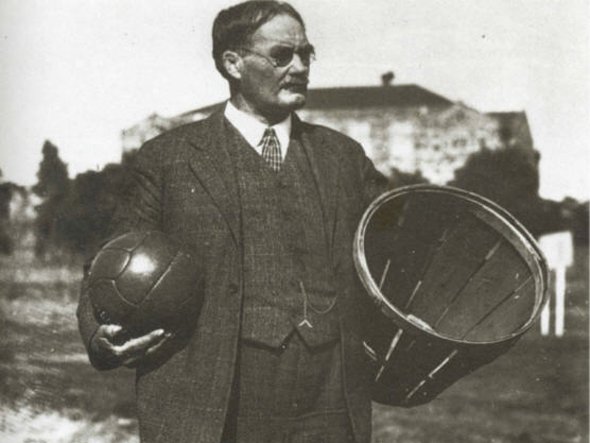Most of the sports that people follow have developed over the years, growing into the games played with the rules known today, making it very difficult to name a single inventor. Football evolved from rugby; variations of soccer have existed for centuries; hockey came from shinny, a sport where the only rule is that there are no rules; and baseball has tons of origin tales. The invention of the sport of basketball, however, can be credited in its entirety to one man; a McGill alum from rural Ontario by the name of James Naismith.
James Naismith was born on November 6, 1861 in Almonte, Ontario, a 2000-person strong lumber town about 50km southwest of Ottawa. His parents—John and Margaret—died of typhoid fever when James was only nine years old, sending him and his two siblings to live with his aunt and uncle on their farm. From an early age, it was apparent that school did not suit Naismith. He prefered to spend his days outdoors playing catch, hide and seek, or duck on a rock, a game in which one person guards a large flat stone stood up on end and opposing players try to knock it down by throwing smaller stones at it. Naismith dropped out of high school in 1877 with the full intention of pursuing a career as a lumberjack, a trade at which he excelled.
“[But one day] he was in the saloon having a drink of whisky, and somebody turned around and said, ‘You’re Margaret Young’s boy, aren’t you?’” said Naismith’s grandson, Stuart. “‘She’d roll over in her grave if she could see you now, drinking.’ So he put down the whisky and never touched another drop as long as he lived.”
Naismith re-entered Almonte High School soon after, graduating in 1883 at the age of 21 and enrolling at McGill the following Fall. Engrained with a newfound desire to serve his fellow man, Naismith hoped to eventually become a minister. He studied harder than he had ever studied before, putting aside sports to spend time on his schoolwork. Dismayed at how quickly he fell out of shape and encouraged by a few classmates, Naismith joined the McGill gymnastics and rugby programs. His first chance to showcase his athletic ability came in rugby tryouts in his first year. Naismith was watching a match from the bench when the McGill centre left the game with a broken nose.
“The coach looked up and saw him standing on the sideline,” said Stuart. “So he said, ‘Naismith, you get in here and play centre.’ So he went in and played centre. He played very well, so they made him part of the team.”
Naismith would start at centre for every subsequent McGill rugby game for the next seven years, completing his BA with honours in Physical Education in 1888 and becoming an ordained minister at the Presbyterian College in 1890. Besides participating in rugby and gymnastics and excelling at his schoolwork, Naismith represented McGill in football, lacrosse, and soccer and still somehow found the time to be active in the Literary and Philosophical Society, the Missionary Society and to write for the Presbyterian College Journal while working as a physical education instructor at the McGill gym to finance his studies. Naismith won the Wicksteed Gold Medal in 1887 for being McGill’s top athlete and became director of athletics the following year—while still a student.
Upon graduation, Naismith chose to combine his two worlds: Athletics and theology. He developed a natural interest in the YMCA movement, present in Montreal since 1851. Naismith was intrigued by the ‘Muscular Christianity’ movement, in which the YMCA taught courses that emphasized spiritual and physical development. Naismith left Montreal to attend the YMCA International Training School in Springfield, Massachusetts to become a YMCA leader, capable of opening and running a YMCA branch.
It was there in 1891, during a particularly harsh New England winter, that Naismith was instructed by one of his superiors to devise an indoor game that would provide an “athletic distraction” to rowdy and confined classes. The game was to not take up too much space, keep its players in shape, and be fair and relatively non-violent. Two weeks later, Naismith returned with an overinflated soccer ball, a repurposed peach basket, and 13 rules for an entirely new sport he called “basket ball.”
Naismith remained with the YMCA until 1898—pausing for long enough to earn a medical degree–and was instrumental in founding the Denver YMCA. Later, he served as physical education director, campus chaplain and basketball coach at the University of Kansas until his retirement in 1938 after serving in WWI in France. The greatest moment of his career, in his own words, came in 1936 when he saw his game—his invention, his gift to humanity—played on the international stage at the Olympics in Berlin.
Naismith passed away in 1939 from heart failure. He is remembered today in the Canadian Basketball, the Canadian Olympic, FIBA and McGill University Sports Halls of Fame. The Naismith Memorial Basketball Hall of Fame in Springfield, Massachusetts—where he is a member of the founding class—was named in Naismith’s honour.









